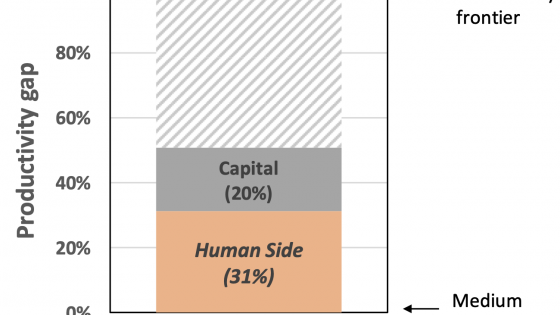Companies, investors, policymakers, and wider society are paying increased attention to diversity, equity, and inclusion (DEI) within firms. DEI initiatives have two motivations: that DEI improves a company’s long-term financial performance, and that it contributes to societal goals. Under both the financial and social motives, the relevant measures of DEI are holistic. New ideas, and thus superior financial performance, stem from cognitive rather than purely demographic diversity. Similarly, social outcomes stem from providing opportunities to under-represented groups across all dimensions, such as demographics, disability status, socioeconomics, and education. Moreover, both goals require not only diversity but also equity and inclusion. Hiring minorities to tick a box, but failing to ensure that they can thrive and be themselves at work, will achieve neither the financial benefits from cognitive diversity nor the social outcome of meaningful employment.
In practice, however, DEI initiatives focus almost exclusively on demographic diversity. For example, Norway introduced a 40% gender quota on corporate boards in 2005, and other countries have since followed suit. Investors have policies to vote against director nominations that do not bring demographic diversity up to a certain level. Companies report the percentage of women and minorities in the wider workforce and sometimes tie executive pay to these metrics. Employees, customers, and the media evaluate how ethical companies are in part based on diversity statistics.
Despite their narrowness, such measures have been justified by research claiming that they are strongly correlated with financial and sometimes social outcomes. Many such papers have been highly publicised and widely shared, in part due to confirmation bias, even though they have important flaws. A series of studies from McKinsey (Hunt et al. 2015, 2018, 2020) claim a statistically significant link between ethnic diversity and firm performance. However, Green and Hand (2021) find that the results cannot be replicated even with the authors’ chosen performance measure (earnings before interest and taxes, or EBIT) and preferred methodology. Moreover, there is no link between diversity and other performance measures – gross margin, return on assets, return on equity, sales growth, or total shareholder return – or when using more established methodologies (for example, considering all the data, rather only the top and bottom quarter of diversity). The Financial Reporting Council (2021), the UK regulator, published a study claiming that “[h]igher levels of gender diversity of FTSE 350 boards positively correlate with better future financial performance (as measured by EBITDA margin)”. Yet out of their 90 regressions linking diversity to the EBITDA margin, none is significant.
More broadly, Fried’s (2021) review of the leading academic evidence finds a negative or insignificant link between demographic diversity and firm performance. An influential early paper is by Adams and Ferreira (2009); Ahern and Dittmar (2012), Matsa and Miller (2013) and Eckbo et al. (2022) study causal effects using Norway’s quota; and Greene et al. (2020) investigate the impact of California’s requirement to have at least one female director. As Edmans (2021a) stresses, this weak evidence does not invalidate diversity initiatives, but does mean that they need to be justified based on the social rather than financial case.
In a new paper (Edmans et al. 2023), we take a first step towards measuring the DEI of a company, employing proprietary data used by the Great Place to Work® (GPTW) to compile the list of the 100 Best Companies to Work For in America. Two thirds of the score that determines list inclusion stems from employee responses to the Trust IndexTM, a 58-question survey on various dimensions of employee satisfaction. Edmans (2011, 2012) finds that the ‘best companies’ enjoyed superior long-term shareholder returns and earnings surprises over a 28-year period from 1984-2011, suggesting that the dimensions captured by the list are financially material. However, that paper only investigates list inclusion, since only this is public.
Via a confidentiality agreement with GPTW, we obtained the individual responses to all 58 questions, for all companies that applied to the list irrespective of whether they were eventually included, from 2006 to 2021. We identified 13 questions that cover DEI, such as “This is a psychologically and emotionally healthy place to work”, “I can be myself around here”, and “Managers avoid playing favourites”. We aggregate employee responses to form a measure that we call DEI. Our measure is a ‘grass-roots’ indicator of actual DEI, as perceived by the responses of between 250 and 5,000 employees in a company, in contrast to more superficial measures such as whether a company has a DEI policy.
As a preliminary result, we show that DEI is only weakly correlated with traditional measures of demographic diversity, such as the percentages of women and ethnic minorities in the board, senior management, CEO position, and wider workforce. For example, its correlation with the percentage of female (minority) employees is 0.16 (-0.04). Thus, our DEI measure contains incremental information that would be missed by standard metrics that focus more narrowly on demographic diversity. This has implications for the substantial attention paid to diversity metrics – they omit a big piece of the picture. Companies can ‘hit the target, but miss the point’ – improve diversity statistics without improving DEI.
We then study the determinants of DEI to understand how it is associated with recent financial performance and firm characteristics. We do not use the word ‘determinants’ in a causal sense, because both financial performance and firm characteristics are endogenous. Rather, we are interested in studying what types of firms are associated with a higher level of DEI. We find that DEI is positively associated with one- and three-year sales growth, positively associated with three-year but not one-year stock returns, negatively associated with leverage, and positively associated with dividends. This suggests that a strong financial position frees a company from having to focus on short-term pressures and instead allows it to address longer-term challenges such as DEI. Small and growth (low book-to-market) firms are associated with higher DEI, consistent with their greater ability to increase DEI, given management’s proximity to workers, and their greater incentives to do so, given the importance of human capital in such firms.
We then study the workplace policies and practices that are associated with DEI. The proportion of women in senior management is positively and significantly associated with DEI across all specifications. However, there is no link between DEI and the presence of a female CEO and a negative association with the percentage of women on the board. We also find that DEI is unrelated or negatively related to ethnic diversity in senior management, at the CEO level or in the boardroom. The insignificance of most demographic diversity variables suggests that an ‘add diversity and stir’ approach is insufficient to improve DEI. We also explore workplace policies – such as childcare, unpaid parental leave days, sabbaticals, and flexitime – to test whether DEI can be easily increased by implementing simple policies. In contrast to this hypothesis, all workplace policies are insignificantly associated with DEI. In addition to policies, we also show that voluntary turnover has no link with DEI, and the percentage of unionised workers is negatively linked. This suggests that DEI cannot be increased by general efforts to improve the workplace, but instead requires specific, targeted initiatives.
We then turn to the consequences of DEI, which again we do not interpret causally. We find that DEI is positively associated with seven out of eight measures of future profitability, such as return on assets, return on sales, profits divided by employees, and sales divided by employees. These results are after controlling for the percentages of female and minority employees; indeed, these variables are insignificantly related to almost all performance measures. In short, DEI is correlated with higher profits, but diversity alone is not. We also find that DEI is positively associated with valuation measures, such as Tobin’s Q, suggesting that the market at least partially incorporates the value of DEI. However, DEI is positively linked to future earnings surprises, indicating that the market does not fully incorporate the performance benefits of DEI.
We also study future innovation performance. DEI is unrelated to either the number of future patents or patent citations. However, the granular nature of our data allows us to stratify the survey responses by job category. We find that DEI perceptions of professionals – a job category that includes R&D staff – are positively and significantly correlated with both innovation measures, but there is no positive link with the responses from the three other categories (executives, managers, and hourly workers). This is consistent with the fact that innovation is most likely to stem from professionals.
Finally, we study future stock returns. Somewhat surprisingly, given prior results on profitability, innovation, and earnings surprises, we find no link between DEI and stock returns, after controlling for either firm characteristics in firm-level regressions or risk in portfolio regressions.
Beyond diversity, our paper highlights the dangers of a box-ticking approach to sustainability (see also Edmans 2021b). Such an approach extends to other sustainability issues such as pay fairness, which is often reduced to the CEO-to-worker pay ratio; environmental performance, which is captured predominantly by carbon emissions; and human capital management, which is typically measured by employee turnover or having certain workplace policies. Defenders of such metrics argue that partial information is always better than no information, even if it’s not the complete picture. However, the metrics may lead to companies, investors, and stakeholders focusing excessively on quantitative factors at the expense of the qualitative. This does not mean that these measures have negative value or should not be disclosed; instead, it highlights that users should be aware of their incompleteness and look beyond the numbers.
References
Adams, R and D Ferreira (2009), “Women in the boardroom and their impact on governance and performance”, Journal of Financial Economics 94: 291–309.
Ahern, K R and A K Dittmar (2012), “The changing of the boards: The impact on firm valuation of mandated female board representation”, Quarterly Journal of Economics 127: 137–197.
Eckbo, B E, K Nygaardt, and K S Thorburn (2022), “Valuation effects of Norway’s board gender-quota law revisited”, Management Science 68: 4112–4134.
Edmans, A (2011), “Does the stock market fully value intangibles? Employee satisfaction and equity prices”, Journal of Financial Economics 101: 621–640.
Edmans, A (2012), “The link between job satisfaction and firm value, with implications for corporate social responsibility”, Academy of Management Perspectives 26: 1–19.
Edmans, A (2021a), “Is there really a business case for diversity?” Medium, 30 October.
Edmans, A (2021b), “The dangers of sustainability metrics”, VoxEU.org, 11 February.
Financial Reporting Council, London Business School and SQW (2021), “Board Diversity and Effectiveness in FTSE 350 Companies”.
Fried, J M (2021), “Will Nasdaq’s diversity rules harm investors?”, Harvard Business Law Review Online.
Green, J and J R M Hand (2021), “Diversity Matters/Delivers/Wins Revisited in S&P 500® Firms”, Working Paper, Texas A&M.
Greene, D, V J Intintoli, and K M Kahle (2020), “Do board gender quotas affect firm value? Evidence from California Senate Bill No. 826”, Journal of Corporate Finance 60, 101526.
Matsa, D A and A R Miller (2013), “A female style in corporate leadership? Evidence from quotas”, American Economic Journal: Applied Economics 5: 136–169.
Hunt, V, D Layton and S Prince (2015), Diversity Matters, McKinsey & Company.
Hunt, V, S Prince, S Dixon-Fyle and L Yee (2018), Delivering through Diversity, McKinsey & Company.
Hunt, V, S Prince, S Dixon-Fyle and K Dolan (2020), Diversity Wins: How Inclusion Matters, McKinsey & Company.






